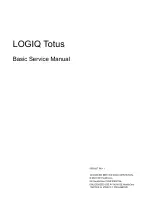
7
DEUTSCH
ENGLISH
FRANÇAIS
ITALIANO
ESPAÑOL
NEDERLANDS
PORTUGUÊS
SVENSKA
DEUTSCH
ENGLISH
FRANÇAIS
ITALIANO
ESPAÑOL
NEDERLANDS
PORTUGUÊS
SVENSKA
© HAAG‑STREIT AG, 3098 Koeniz, Switzerland ‑ HS‑Doc. no. 1500.7220055‑04150 – 2022 – 09
or chamber depth being inaccurate by the thickness of the IOL (ap-
prox. ±1 mm).
• The measured corneal thickness is not intended as a basis for the
correction of intraocular pressure readings for diagnosing glaucoma.
• An excessively tilted or decentered IOL may make it impossible to
measure the anterior chamber depth, lens thickness and aqueous
depth.
• Measurement readings obtained from patients with a non-intact
cornea (e.g., due to a corneal transplant, corneal opacity or corneal
scarring, etc.) may possibly be inaccurate (this applies to kerato-
metry in particular), and the user should check the data for plausibil-
ity.
• Ambient light has an impact on pupil-diameter measurement read-
ings. The user is responsible for ensuring the correct level of ambi-
ent light when carrying out pupillometry. The device does not monit-
or ambient light, so do not use pupillometry as the decisive factor
when considering kerato-refractive surgery.
• Keratometry may not be accurate in eyes with keratoconus, and so
the user must verify its plausibility.
• The user must verify that the eye assignment (OD, OS) is correct for
the measured eye.
• The white-to-white distance reading is merely an indirect measure-
ment of the inner lateral dimensions of the anterior ocular section. It
therefore provides only approximate indications of the actual inner
lateral dimensions of the anterior ocular section and of the size of
the implant used.
• The measured results of patients with asteroid hyalosis may not be
accurate (in particular the axial length measurement) and must
therefore be verified by the user in terms of their plausibility.
• If the optional T-Cone is used, the user should verify the even illu-
mination of the cone.
1.7 IOL calculation
The measurements taken with the LS 900 are a central element of every IOL calcu-
lation. A further important parameter in calculating the lens to be implanted is the
IOL constant. When using the Lenstar LS 900, only IOL constants optimised for op-
tical biometers should be used. Please contact your IOL manufacturer for informa-
tion on optimised IOL constants for optical biometry. An alternative source of inform-
ation for IOL constants optimised for optical biometry is the website of the 'User
Group for Laser Interference Biometry' (ULIB) at the University of Wuerzburg, Ger-
many. Even though the constants published there have been optimised for a differ-
ent optical biometer, published data [1, 2, 3] indicate that these IOL constants can
also be used for calculating IOL power with the Lenstar. Downloadable IOL Con-
stants files for the Lenstar, featuring the ULIB IOL-Constants for the Haigis, Hoffer
Q, Halladay I, SRK/T and SRK II - Formulae as well as IOL Constants for the use
with the Olsen Formula are available in the Key-User section of the Haag-Streit
homepage.
To further improve the clinical result, Haag-Streit recommends that every surgeon
creates personally optimised IOL constants based on pre-operative measurement
data generated with the Lenstar and reliable postoperative data (e.g., 3 months after
the operation).
1.7.1 References
[1] Buckhurst P J, Wolffsohn J S, Shah S, Naroo S A, Davies L N, Berrow E J, 'A
new optical low coherence reflectometry device for ocular biometry in cataract pa-
tients', British Journal of Ophthalmology 2009;93:949-953
[2] Holzer M P, Mamusa M, Auffarth G U, 'Accuracy of a new partial coherence in-
terferometry analyser for biometric measurements', British Journal of Ophthalmology
2009;93:807-810
[3] Rohrer K, Frueh B E, Wälti R, Clemetson I A, Tappeiner C, Goldblum D, 'Com-
parison and Evaluation of Ocular Biometry Using a New Noncontact Optical Low-
Coherence Reflectometer', Ophthalmology 2009, 116:2087-2092
1.8 IOL constants
Haag-Streit recommends using personalised IOL constants to achieve maximum
prediction accuracy of the IOL calculation. Using personalised IOL constants minim-
ises the effects of individual surgical techniques, individual measurement and sur-
gical equipment and individual physiological differences in the patient cohort under
treatment on the IOL calculation.
WARNING:
It is the user's responsibility to use correct values of personalised IOL
constants.








































